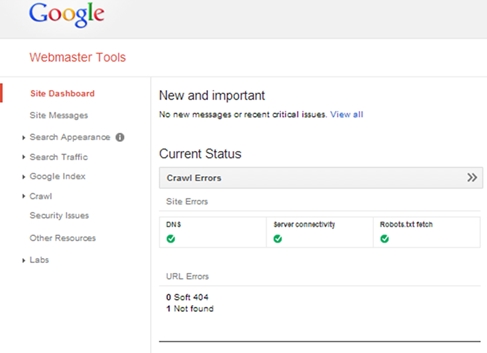
Google webmaster tools are an important addition to any analysis resources. They are free, and can give important insights into more technical aspects of site performance on Google’s search platform.
The first step is to submit a sitemap to Google. This is very easy, and once submitted, Google can accumulate statistics about the site. There is also a very important messages to look out for, which will be covered in more detail later.
On the Webmasters’ home page, in the top right hand corner is a red box “Add a Website”. Clicking on this opens a pop up where the full site name is entered. It is then necessary to verify the site with Google, to prove that the person registering the site is the owner and has access rights to it. Of the four options to verify the site, by far the easiest is to download a Google html file then upload it to the site’s root directory.

Once the file is uploaded to the site, it must be published, approved and completed prior to verifying the site with Google. For guidance on how to upload files, see this Dating Factory tutorial here.
Once verified, the sitemap, which contains information for Google to use to index the site pages, can be submitted. The site dashboard has these sections, one of which is to access the sitemap submission page; the left hand section lists the tools available, which future articles will explore in more depth.

The middle section gives an overview of natural search results, and an indication of how changes to on page and off page SEO areas impact natural search:

The right hand section reports on how many URLs are in the sitemap and how many Google has indexed, i.e. how many pages Google considers to be unique:

Review Google’s Messages
One critical area to review regularly is Google messages about the site, especially any which says “Googlebot can’t access your site”. This message can be caused by a number of factors, primarily outages on the site servers, which are few, but if they happen to coincide when Googlebot is trying to access the site, this message will be generated.
If this happens, the site will be de-indexed by Google and will not appear in natural search results.
This action by Google is primarily to maintain the quality of its search results for links which work and are “live”. If Googlebot can’t access a site, it classifies the links as “dead”, and sends a message to that effect.
If this happens and development work is undertaken on the site, it won’t make any difference to Google’s “dead link” flag. However, this can be easily fixed, as Google provides the tool to re-list site links.
In the body of the email, look for this text towards the bottom of the email: “After you think you’ve fixed the problem, use Fetch as Google to verify that Googlebot can properly access your site.” This manual action, assuming that the site is live and accessible, will re-state the site links as live, and they will be re-indexed by Google. NB if you run Google Adwords, ads are also disapproved if Googlebot can’t access your site, so keep a lookout for ad disapproval emails as well, as an indicator that the site may be temporarily de-indexed.
Future articles will explore more insights available through Google Webmasters tools.
In Summary:
- Google Webmaster Tools, free to use, provide a more technical insight into a site’s performance on Google’s search engine platform;
- Verify site ownership and upload a sitemap to index site pages;
- Use the reporting of search queries to assess site performance for natural search on Google’s platform;
- Review regularly site messages, especially looking out for a message that “Googlebot can’t access your site”;
- Use the “Fetch as Google” tool in the email to report to Google that the site and its links are live to get them re-indexed;
- If you run Google Adwords campaigns, watch for Ads Disapproval messages where Googlebot can’t access your site as another indication that the site has been de-indexed – then go fix it.
Good luck!